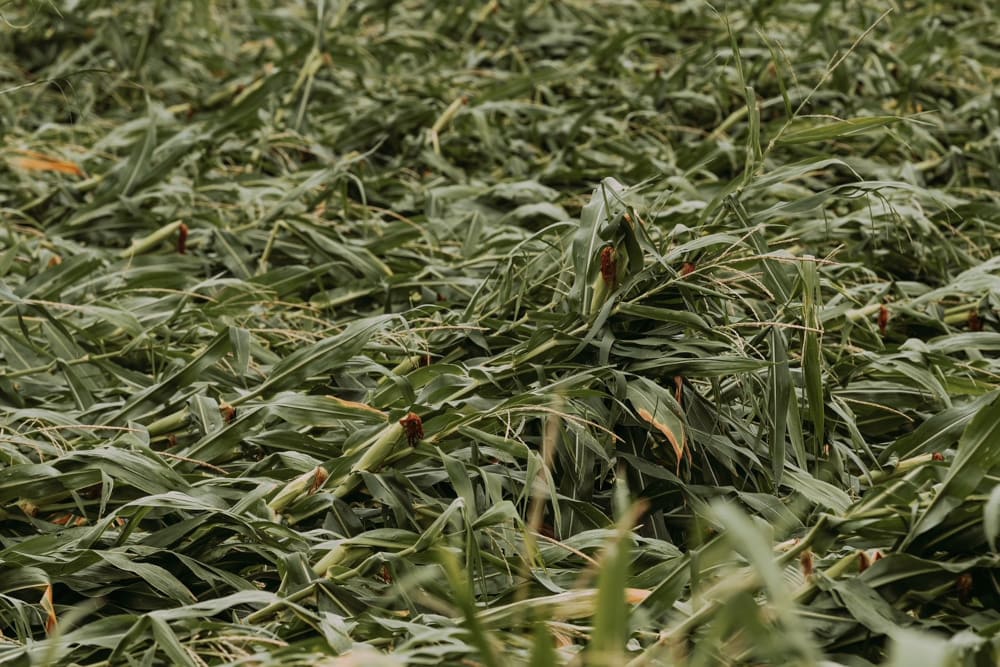Tips For Harvesting Storm Damaged and Downed Corn
Use a drone to get an aerial view of your field. This will help you determine the extent of the damage as well as assist in locating any foreign debris the storm has deposited there.
Review your crop insurance policies and take appropriate actions BEFORE starting a corn harvest for a downed crop.
Unfortunately there is no “Silver Bullet” for successfully harvesting a downed crop. Oftentimes the variables are different and what works well for 1 instance does not for another, so a bit of experimentation is in order. That being said, there is a consensus amongst farmers that some methods work better than others. So here goes:

Patience Is King When Harvesting A Downed Crop
Harvest time is a stressful time for farmers as they try to cut corn silage at an optimum moisture content for fermenting. Now factor in that your entire crop lays flattened by last night's storm and has already begun drying down. The corn on the top of the blowdown will lose moisture content rapidly, while the crop underneath will retain a higher moisture content for a much longer period of time.
Depending on the overall condition of the crop the time it takes to complete the harvest can be extended by as much as 100%. Now more than ever before the old adage, “Haste Makes Waste” needs to govern your every move.
Be patient, take the time to figure out the method that salvages the most from your crop, give your chopper the time it needs to work through the mass of jumbled stalks it is being force fed. Likely you are running with your heads closer to the ground than normal, take the time to spot storm debris BEFORE running it thru your machine, leading to a breakdown.
Row Dependent vs Row Independent Rotary Heads for Downed Corn?
The Iowa Derecho in 2022 which took down several million acres of corn has helped farmers to identify some harvest methods that were considerably more effective than others. Observations worth considering were as follows:
Row Dependent harvesting was found to be reasonably successful when the field was downed by straight line winds and you harvest with the downed stalks leaning into the machine. Then deheading back to the other end of the field for your next pass in the same direction. Remember to keep your ground speed down to avoid clogging, as you are feeding most of the stalks backwards.
Harvest yields and efficiency tended to be higher when a Row Independent Rotary Head is used for the harvest rather than a Row Dependent Head. Those harvest yields and efficiency remained higher even when the stalks were strewn in multiple directions.
With a row independent head you were able to harvest in both directions rather than deadheading to the other end of the field. Some operators were able to increase yield and efficiency by harvesting across the rows rather than running with them.
Running rotary heads at higher than normal speeds will help to bring the material into the machine, minimizing loss. Experimenting with head angle and height was also found to impact yield and efficiency. A word of caution here, running with the head low enough to get under downed crop is oftentimes an invitation for trouble, stay low but travel slowly and be alert for foreign debris lurking among the stalks.
Use A Horning Row Independent Corn Head to Salvage Downed Corn
A downed corn crop 4 weeks before harvest is enough to ruin any farmers day, but all is not lost. Horning Mfg has been innovating the corn harvest for such a time as this. Row Independent Corn Heads were designed to obtain maximum efficiency and recovery during a downed crop harvest.
Horning row independent corn heads eliminate two potential pain points during a storm damaged crop harvest:
Gathering Chain Issues: In downed corn the potential for foreign material to be brought into the harvester is greater. On a machine with gathering chains this means higher potential for clogging or jamming. Horning row independent heads make this a non-issue since they do not have gathering chains.
DeadHeading: Cornstalks strewn in all directions means a lot of deadheading for traditional harvesters. Horning row independent heads are not row dependent, therefore deadheading time is drastically reduced or eliminated.
Tips For Setting Up A 3 Row, Horning Row Independent Corn Head To Harvest Downed Crop
- Remove the Triangle cone on the right rotor, to allow tangled crop to flow back further.
- Remove the cob saver above the rotor to minimize material flow restriction.
- Disregard rows and try to drive with the majority of the stalks leaning towards the right. You may need to try a few variables to find best scenario for your conditions